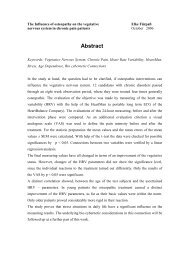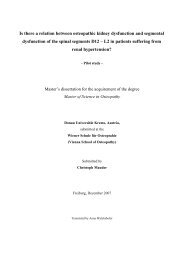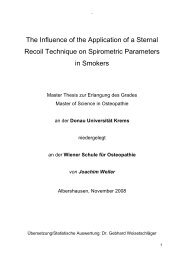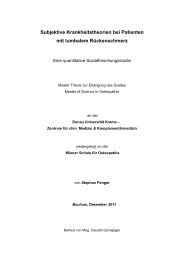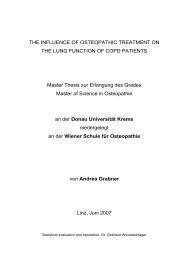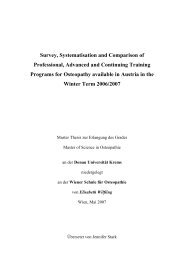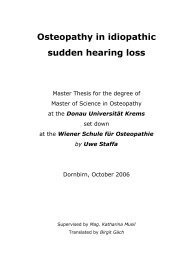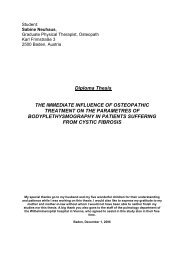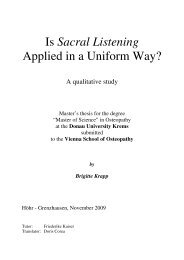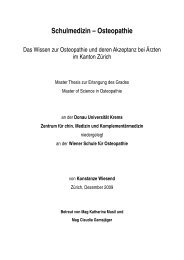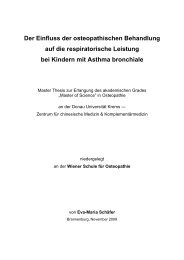Can back pain caused by symptom-giving sacroiliac joint relaxation ...
Can back pain caused by symptom-giving sacroiliac joint relaxation ...
Can back pain caused by symptom-giving sacroiliac joint relaxation ...
You also want an ePaper? Increase the reach of your titles
YUMPU automatically turns print PDFs into web optimized ePapers that Google loves.
this study he included the examination for sensitivity and specificity. Only a minimum<br />
of three tests have to be positive to indicate SIJ instability. Since the latter series with<br />
six provocation SIJ tests offers more accurate results as regards specificity and<br />
sensitivity, I chose to apply these tests in my study. [31]<br />
For the assessment of <strong>pain</strong> provocation SIJ tests, <strong>pain</strong> areas and palpation, a more<br />
affected side (MAS) and a less affected side (LAS) were defined. This classification<br />
refers especially to the instability of the SIJ. However, it contradicts the holistic<br />
approach of osteopathy, as restrictions in an osteopathic sense can be found<br />
especially on the LAS.<br />
The results obtained from Laslett’s test series were very significant. However, it is<br />
important to point out that the inclusion criterion of this study was the test series<br />
itself, which raises the significance of its results.<br />
The cranial shear test also shows significant results for my work and a clear<br />
coherence with Laslett’s test series of 2005. [31] In Laslett’s study of 1994 this test<br />
still formed part of his test series. Unfortunately the current study report does not<br />
offer any explanations as to why this test is no longer included in the test series.<br />
The ASLR and Faber tests also show an improvement after therapy. However, their<br />
results do not significantly point towards the presence or absence of SIJ instability.<br />
With their ASLR test method Mens et al. [31] have shown good results regarding<br />
reliability and the specificity and sensitivity on the Quebeck Back Pain Disability<br />
Scale. Due to the scaling of results, using this test version in day-to-day work life is<br />
considerably less convenient.<br />
The SLR tests after the treatments do not only show improved results in the area of<br />
the SIJ but also in the adjacent areas. However, the significance of these results is<br />
not sufficient to draw generally valid conclusions.<br />
As regards the <strong>pain</strong> areas, these were not assessed according to their quantity, but<br />
regarding whether <strong>pain</strong> occurs at all in these areas. In many cases it was possible to<br />
achieve <strong>pain</strong> reduction in a certain area, but never <strong>pain</strong>lessness. Thus, the indication<br />
of the <strong>pain</strong> area(s) is not significant for the success of the therapy.<br />
Master’s Thesis Wolfgang Aspalter 64



